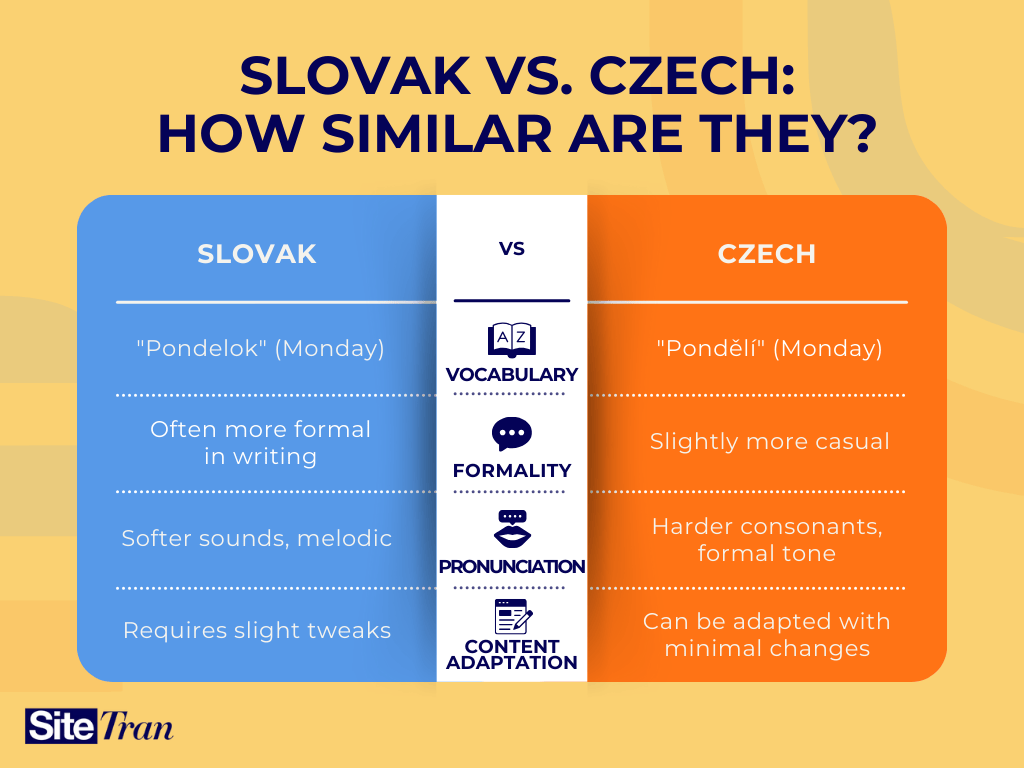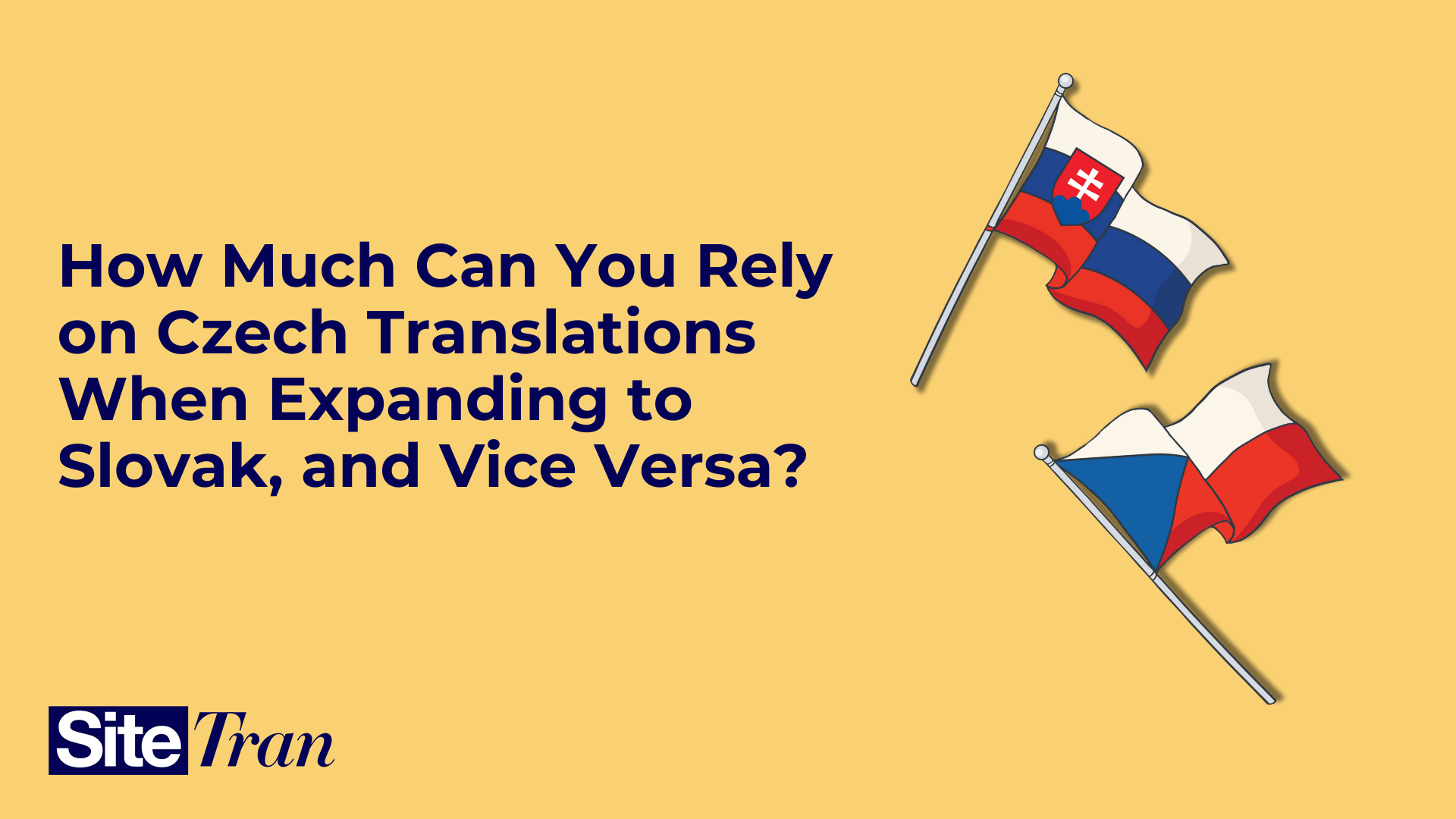Introduction: Expanding into Central Europe with Slovak and Czech
As a business looking to reach audiences in Central Europe, you might be wondering if content created for the Czech-speaking market can be easily adapted for Slovak speakers. Slovak and Czech are closely related languages, sharing a long history and many linguistic similarities that allow speakers of each language to understand each other with relative ease. However, despite the high degree of mutual intelligibility, important distinctions exist that make direct translation shortcuts less effective for certain types of content. In this post, we’ll explore how you can leverage existing translations from one language to the other, when separate translations are necessary, and how a translation tool like SiteTran can simplify the process of reaching both Slovak and Czech-speaking audiences.
1. Understanding the Similarities and Differences Between Slovak and Czech
Mutual Intelligibility
Slovak and Czech are among the most mutually intelligible languages in Europe, particularly in written form. Due to shared linguistic roots and close cultural ties, Czech speakers can generally understand Slovak and vice versa, especially when it comes to basic vocabulary, grammar, and sentence structure.
Pronunciation and Dialects
While the languages are mutually intelligible, differences in pronunciation and dialect can impact understanding, especially in conversational contexts. Czech often sounds slightly more formal, with different accents and intonations that Slovak speakers may find distinctive.
Vocabulary and Grammar Variations
Although much of the vocabulary is shared, each language has unique expressions, spellings, and nuances that need adjustment in professional content. For example:
- Days of the Week: Czech uses pondělí for Monday, whereas Slovak uses pondelok. Small changes like these can add up, affecting how natural and readable the content feels.
- Formality in Address: In Slovak, certain expressions are more formal or polite compared to Czech, especially in written communications and customer-facing content.
Direction for Websites
Both languages are written left-to-right, so structural adjustments to the website layout aren’t necessary. However, attention to vocabulary and phrasing is essential to ensure the content resonates with each language community. For businesses that need to localize for both audiences, a translator familiar with the nuances of both Slovak and Czech can often adapt a significant portion of the content with minimal changes.

2. Translation Shortcuts: Can You Leverage Existing Translations?
Given the high degree of similarity between Slovak and Czech, can a Czech translation serve as a base for Slovak? Often, yes—especially for non-creative or factual content.
For technical or factual content like product descriptions, legal disclaimers, or support articles, a Czech translation can often be adapted for Slovak (or vice versa) with adjustments to vocabulary and formality. In these cases, a translator can refine minor details to make the content accessible and authentic for Slovak speakers.
For marketing or culturally resonant content, a separate translation is recommended. Certain phrases or tones that work in Czech may not have the same impact in Slovak due to slight cultural and linguistic differences. For example:
- A Czech advertising campaign that uses nejlepší nabídky (best offers) might need slight tweaking for Slovak to make the wording feel natural and appealing, especially if the tone needs to be friendlier or more formal.
3. Cost-Benefit Analysis: When to Invest in Separate Translations
When deciding between adaptation and a unique translation, it’s helpful to consider the type of content and its role:
- General Information or Technical Content: For straightforward product descriptions, instruction manuals, or FAQ sections, adapting Czech content for Slovak can work well. The translator can make minor changes to vocabulary, grammar, and formal tone to meet Slovak language standards.
- Marketing, Conversational, or Brand-Centric Content: For customer-facing content like brand stories, About Us pages, or social media posts, a unique translation may better capture the tone and subtle cultural differences of each audience. Although small, these differences in phrasing and formality can influence audience perception and engagement.
Example Scenario: Imagine you manage a SaaS company targeting customers in both the Czech Republic and Slovakia. The product’s support documents and FAQ can likely be adapted from Czech to Slovak with minor tweaks in terminology and phrasing. However, the homepage, which conveys the brand’s identity and value proposition, would benefit from a dedicated Slovak translation to ensure the tone resonates with Slovak customers.
4. Streamline Your Process with a Website Translation Tool Like SiteTran
When managing translations for similar languages like Slovak and Czech, SiteTran can simplify and streamline the process, helping your team adapt content efficiently without sacrificing accuracy. Here’s how SiteTran supports the process:
- Efficient Management and Communication: With SiteTran’s centralized platform, you can keep projects organized, communicate directly with translators, and track all changes in real time. This is especially useful for languages as similar as Slovak and Czech, where minor adjustments can make a big difference in readability.
- Glossary for Consistency: SiteTran’s glossary feature allows your team to ensure consistency across languages, particularly helpful for technical terminology or phrases that should remain uniform across Slovak and Czech.
- AI-Powered Translation Suggestions: SiteTran’s AI suggestions provide a starting point for translators. For closely related languages, these suggestions can save time by proposing common vocabulary and phrasing, allowing translators to focus on refining tone and vocabulary.
- Translation History: SiteTran’s history feature allows you to reference past translations for continuity in style and phrasing. This is ideal for maintaining consistency, especially when expanding content for audiences in both countries.
SiteTran provides a streamlined process for managing Slovak and Czech translations, ensuring content that feels authentic and culturally relevant.
5. Best Practices for Businesses Targeting Slovak and Czech Speakers
For businesses adapting content between Slovak and Czech, here are some best practices to maximize the impact of your translations:
- Adapt, Don’t Just Translate: Make sure each version feels native and natural. Even small changes in phrasing can enhance readability and help content resonate with the target audience.
- Prioritize Key Content: Focus on adapting high-priority pages like your homepage, product descriptions, and brand messaging, as these often have the most significant impact on user perception.
- Test for Readability: Consider A/B testing content with native speakers to ensure readability and engagement. Testing can provide valuable insights into how well your translations resonate with each audience.
Conclusion: Make the Most of Slovak and Czech Translations
Expanding into both Slovak and Czech markets offers a valuable opportunity to reach a broader audience in Central Europe. While the similarities between Slovak and Czech allow for efficient adaptations, the subtle differences in vocabulary, tone, and cultural expectations mean that a direct copy often isn’t enough to create a truly engaging experience.
Using a translation tool like SiteTran simplifies the process of managing and adapting translations, allowing you to easily tailor content for both languages. With features like glossaries, AI-powered suggestions, and translation history, SiteTran helps streamline adaptation while maintaining accuracy and consistency.
By approaching Slovak and Czech translations strategically, your business can create a cohesive, localized experience that resonates with both language communities, strengthening your brand’s reach across Central Europe.

